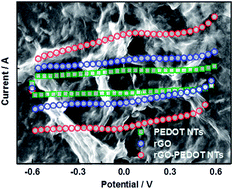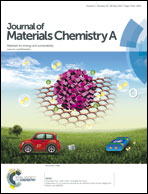A high performance electrochemical sensor for acetaminophen based on a rGO–PEDOT nanotube composite modified electrode†
Abstract
In this study, we perform an electrochemical sensing using a conductive composite film containing reduced graphene oxide (rGO) and poly(3,4-ethylenedioxythiophene) nanotubes (PEDOT NTs) as an electrode modifier on a glassy carbon electrode (GCE). Scanning electron microscopy suggests that the rGO covers the surface of GCE uniformly and the PEDOT NTs act as a conducting bridge to connect the isolated rGO sheets. By combining these two materials, the conductivity and the surface coverage of the film can be enhanced, which is beneficial for electrochemical sensing. The rGO–PEDOT NT composite modified electrode is applied for an effective sensor to analyze acetaminophen. The obtained electrochemical activity is much higher than those obtained by the rGO- and PEDOT NT-modified electrodes; the higher electrochemical activity may be attributed to the higher conductivity and greater coverage of the rGO–PEDOT NT composite film on the GCE. Furthermore, interference tests indicate that the rGO–PEDOT NT composite modified electrode exhibits high selectivity toward the analyte. This novel method for combining the rGO and PEDOT NTs establishes a new class of carbon material-based electrodes for electrochemical sensors.


 Please wait while we load your content...
Please wait while we load your content...